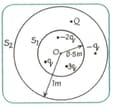Kumar Mittal Solutions for Exercise 1: QUESTIONS
Kumar Mittal Physics Solutions for Exercise - Kumar Mittal Solutions for Exercise 1: QUESTIONS
Attempt the practice questions from Exercise 1: QUESTIONS with hints and solutions to strengthen your understanding. NOOTAN ISC PHYSICS Class 12 Part-1 solutions are prepared by Experienced Embibe Experts.
Questions from Kumar Mittal Solutions for Exercise 1: QUESTIONS with Hints & Solutions
A plane surface of area is placed in the X-Z plane where an electric field exists. Calculate the electric flux passing through the surface.
In the figure charges are enclosed by spherical surfaces and If the electric flux through surface is four times that of electric flux through, find relation between and .

State Gauss’ theorem in electrostatics.
Apply this theorem to derive an expression for the electric intensity due to an infinite sheet of charge and hence deduce the expression for electric intensity due to two parallel oppositely charged thin infinite sheets of charge at a point
(ii) Outside the sheets.
Using Gauss’ theorem, derive an expression for the electric field intensity due to a charged thin spherical shell at Surface point.
Draw the graph showing the variation of electric field intensity obtained as above with distance from the centre.
Using Gauss’ theorem derive an expression for the electric intensity due to a charged thin spherical shell at
internal point.
Draw the graph showing the variation of electric intensity obtained as above with distance from the centre.
A point-charge produces an electric flux of through a spherical Gaussian surface of radius with centre at the charge.
What is the magnitude of point-charge?
A sphere of metal has a radius of and carries a charge of , distributed uniformly on its surface. Calculate the electric field intensity at a point just outside the sphere.
A sphere of metal has a radius of and carries a charge of , distributed uniformly on its surface. Calculate the electric field intensity at a point from the centre of the sphere.
